Steps to create Facebook ads
With more than 1.4 million users and more than 900 million hits a day, Facebook is one of the most useful advertising tools for companies and businesses.
In the article below, Network Administrator will guide you through the steps to create an ad on Facebook.
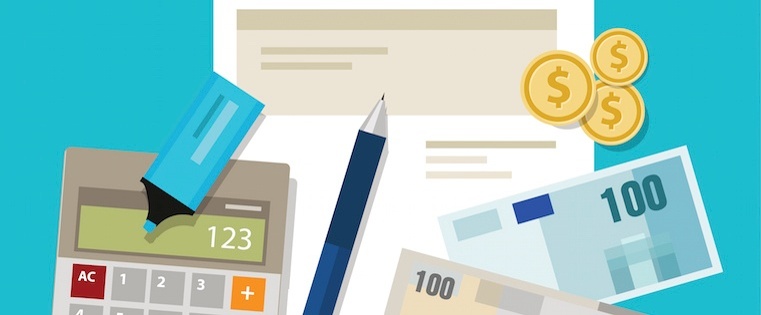
Create and optimize Facebook ads
Facebook offers a wide range of advertising payment options and ad placement. However all ads can be divided into 3 elements:
- Campaign : Contains all your assets.
- Ad sets: If your goal is to target many customers of different ages and personalities, you must create an individual ad set.
- Ads (single ads): actual ads are in your ad sets. Each ad set can organize a variety of ads with different colors, images .
1. Define the Editor best suited
Facebook provides users with 2 different tools to create ads: Ads Manager and Power Editor. When deciding on the best tool, you need to consider the size of the company, the number of ads you want to run at the same time.
While Ads Manager is suitable for most companies, Power Editor is like a tool for big advertisers looking for.
2. Select an advertising campaign
Facebook's Ads Manager is like media advertising media systems, designed to promote your campaign. Before starting Ads Manager will prompt you to select a target for your campaign.
There are 10 different goals for you to choose from. When you choose one of these goals, you're providing Facebook with a great idea for Facebook to introduce you to the best advertising options. Facebook advertising options include:
- Page Post Engagements
- Page Likes
- Click to Website
- Website Conversions
- App Installs
- Engagement App
- Event Responses
- Offer Claims
- Video Views
- Local Awareness
If the purpose you are looking for is to increase your website traffic. When you select this option, Facebook will prompt you to enter the URL you are looking for to boost traffic. If you are using automated marketing software, you need to ensure that you create a unique URL with UTM parameters to ensure tracking traffic and conversation from ads.
After selecting Facebook will display the most appropriate advertising options to help you achieve your goals.
3. Select the object
If you start with paid advertising on Facebook you will have to test many different options until you choose the most suitable audience.
To help you "narrow" your focus, Facebook will provide you with a "measure" tool to identify your audience.
This tool is on the right of the frame. Targeting targeting - there are all the attributes you can choose from, considering to make Potential Reach.
Potential Reach can be interpreted as potential access.
If you are wondering between choosing a specific audience on a large scale, you should reconsider your goals.
If the goal you are looking for is to increase the amount of traffic for your site, you should focus on the audience who is interested in your content.
However, if the goal you are looking for is to build or promote a brand, you can focus on a generic audience.
Facebook integrates a number of options targeting large-scale objects such as:
- Location
- Age
- Gender
- Languages
- Relationship
- Education
- Work
- Financial
- Home
- Ethnic Affinity
- Generation
- Parents
- Politics (US only)
- Life Events
- Interests
- Behaviors
- Connections

You can also choose the Custom Audience option - this option allows you to target Facebook users in your company's contact database, website visitors or application users, your game
Once it detects that a group of people respond well to your ad, Facebook will allow you to save those objects for future use.
4. Making Budget
Facebook provides advertisers with the option to set a Daily or Budget Budget in the Lifetime style (campaign lifecycle).
Budget-style Daily: If you want your ads to run continuously every day, this is the best option. Using Budget in a daily manner means Facebook will place your ads by day. Remember that the minimum Budget Daily for an ad is 1.00 USD.
Budget in the Lifetime style: If you are looking to run ads in a specific time period, you should select Budget under Lifetime style. Using Budget in Lifetime mode means Facebook will place your ads in a specific time period.
To determine your Budget, you can switch to some advanced options. Here you can set up some other specific options like:
- Schedule:
Choose whether you want your campaign to run immediately and run continuously or customize the start and end dates. You can also set parameters for your ads to run only during specific hours and weekdays.
-Optimize and price:
Choose whether you want to pay, click or display directly. (This will change the way your ads are displayed and you have to pay fees.)
In this way, you will pay for your ad to be displayed in the list of your target audience, but Facebook will control what you bid the most.
If you don't want Facebook to set an optimal bid for you, you can choose your bids manually. This option gives you full control over how much you are willing to pay for each process. However, Facebook will offer suggested bids based on the behavior of other advertisers to give you the choice you should use.
- Delivery:
Delivery includes 2 types: Standard and Accelerated. Delivery Standard usually displays your ads all day. Delivery Accelerated helps you reach your audience quickly for ads in sensitive time periods (Note: this option needs to bid manually).
5. Create your ad
What do you want your ads to look like? All this depends on what your purpose is.
If the purpose you are looking for is to increase the number of clicks on your site, Facebook's Ad Manager will suggest you Click to Website advertising options.
This advertising option is divided into two types: Links and Carousels. Basically this means you can display an image ad (Links) or polymorphic ad (Carousela) with 3-5 free images.
Advertise as Links:
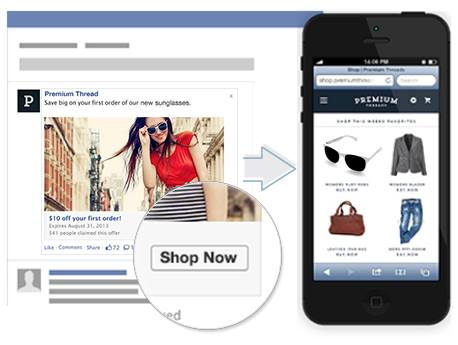
Advertise as Carousels:
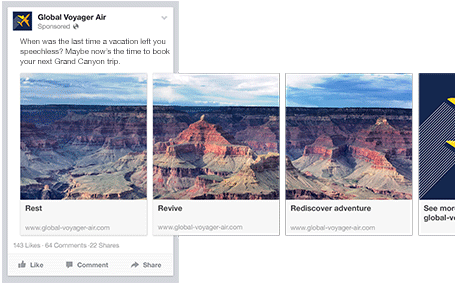
Once you've made your selection, proceed to upload your creative assets. It is important to note that for each type of advertising, Facebook will require users to follow a certain design.
- With single ads (ads with only one image), users must comply with the design:
- Text: 90 characters.
- Link Title: 25 characters.
- Image ratio: 1.91: 1.
- Image size: 1200 pixels x 627 pixels (With ads appearing on News Feed, use a minimum image of 600 pixels wide).
- With polymorphic ads, also called Carousel ads, Facebook provides design:
- Image size: 600 x 600 pixels.
- Image ratio: 1: 1.
- Text: 90 characters.
- Headline: 40 characters.
- Description link: 20 characters.
- Also your image contains no more than 20% of characters.
After selecting the ad type, Ads Manager will prompt you to choose how to display ads. Available options are: Desktop New Feed, Mobile New Feed and Desktop Right Column.
- Desktop New Feed:
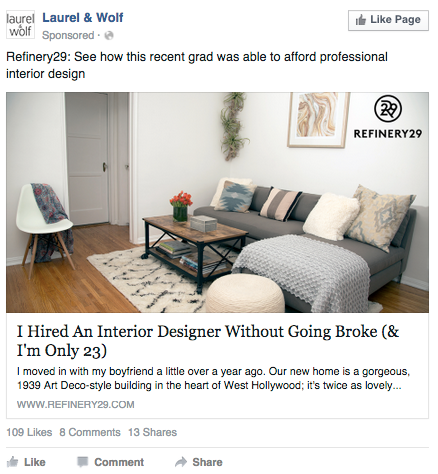
- Mobile New Feed:
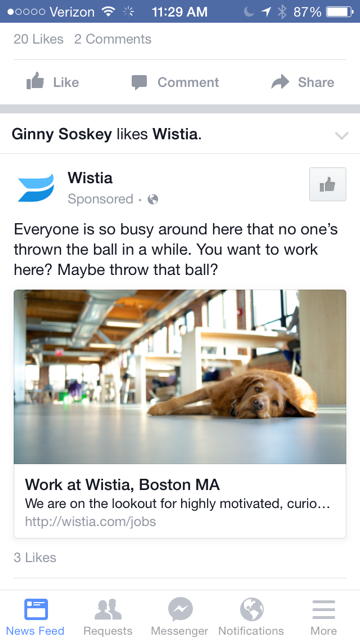
- Desktop Right Column:
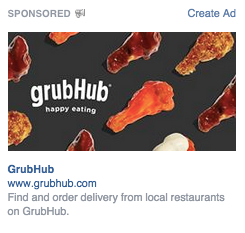
6. Performance report
After the ad has run, your task is to track your ad.
Facebook Ad Manager:
Facebook's Ad Manager is a rather sophisticated dashboard, which gives users an overview of all their campaigns.
The panel is organized, organized by columns, so users can easily filter ads, reach, frequency .
According to Facebook, here are some key to search:
- Performance: Can be customized more metrics such as results, reach, frequency and impressions.
Impression is the term for the frequency of your ad displayed. Impressions are counted every time an ad is displayed on the search results page or other websites on the Google Network. Each time your ad appears on Google, it counts as an Impression.
- Engagement: You can customize the data like page likes, page engagement and post engagement.
- Video: Can customize additional data such as video views and average. % of videos are viewed much
- Webiste: Can customize additional data such as actions (all), payment, payment details, purchase and add to the cart.
- Apps (applications): Can customize additional metrics such as application settings, application participation, mobile application actions and costs for each participating application .
- Events : Can customize additional data such as event response and response cost for each event.
- Click: Can customize additional data such as mouse click, number of clicks, CTR (clickthrough rate) and CPC (cost per click).
- Settings (settings): Can customize additional metrics such as start date, end date, naming ad, advertising ID, distribution, bidding and objectivity.
Marketing software:
Reporting clicks and conversations from Facebook is quite important. However, if you are using URS with a specific UTM code, you have the opportunity to effectively "measure" the advertising channel you are using marketing software.
Tracking URLs will help your marketing software keep track of how many customers you have gained from ads.
This information is extremely useful in determining the source ROI, but you can also be used to inform your strategy.
Refer to some of the following articles:
- How to detect sneaky people on your Facebook
- How to identify an unauthorized login IP address of your Facebook account
- Turn off Facebook, take time to visit these 37 Web sites to add new knowledge every day
Good luck!
You should read it
- How to create a Facebook account
- Summary, all things from A to Z to Facebook
- Here's how to choose the type of Facebook ad that shows up on your Facebook
- 32 Facebook shortcuts help you work faster
- How to create a Facebook nick, register Facebook quickly
- Everything about Facebook Workplace anyone should know
- How to fix when Facebook is infected with virus
- Everything you need to know about Facebook Groups
- Create style for Facebook Avatar with two attractive features
- Guide to creating events, activities on Facebook
- Instructions for creating groups on Facebook
- Best Facebook name, meaning, unique, funny, mood
May be interested

How to convert avatar Facebook into different national flags

Good tips for Facebook

Guide to change the avatar Facebook according to the fans team

Instructions on how to prevent Facebook from sending the message 'This day old'

Tips that make it hard for others to find you on Facebook

Instructions to remove unnecessary applications on Facebook




 Here's how to choose the type of Facebook ad that shows up on your Facebook
Here's how to choose the type of Facebook ad that shows up on your Facebook How to fix when Facebook is infected with virus
How to fix when Facebook is infected with virus How to create a Facebook account
How to create a Facebook account Guide to creating events, activities on Facebook
Guide to creating events, activities on Facebook How to browse Facebook via Tor in 5 steps
How to browse Facebook via Tor in 5 steps